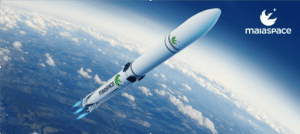
Paris, 25 January 2022. – ArianeGroup is developing the concept of a new European launcher family with a reusable first stage and a new mini launcher called Maia, the company said.
The new launcher family consists of a mini launch vehicle with a reusable first stage, a medium-heavy launch vehicle, a heavy launch vehicle and a super-heavy launch vehicle that uses the first stage of the mini launch vehicle as a booster, ArianeGroup said.
The concept of a modular, reusable and environmentally sustainable European launch vehicle fleet is built on the current ESA and Ariane programs, like Ariane 5 and 6, Prometheus, Themis, Astris, and Phoebus. But it is also adding a new layer, Maia, a reusable mini launcher with green propellants developed by MaiaSpace, a startup-like affiliate of ArianeGroup.
Maia will be able to carry small and mid-sized satellites from 50 to 500 kg and, in an extended version, even up to 1.5 tonnes. The logic of Maia is to cooperate with the industry and invite new entrants to invest in MaiaSpace in a second step, ArianeGroup said. Maia’s first flight is scheduled for 2026.
ArianeGroup proposes its modular concept to the European Space Agency (ESA) through NESTS – which stands for New European Space Transportation Solutions. NESTS is a “vision for the future of space transportation in Europe”, ArianeGroup said, based on a paradigm shift from a “point-to-point” logic to a “network space logistics approach”.
The concept suggests a logic “where launch vehicles can serve variable orbits, e.g., low Earth orbit and a new high parking orbit over the Van Allen belt, and, from there, transport vehicles in space would take over the relay and deliver the payload to its final destination”.
The launch system could also allow Europe to enter human spaceflight and bring European astronauts to the Moon and beyond.
“With our launcher family concept, we are revolutionizing European space transportation and ensuring Europe’s safe and sustainable access to space,” ArianeGroup added. “We are on track to accelerate Europe’s access to space, foster synergies, join forces and contribute to Europe’s leadership and sovereignty in space.”





